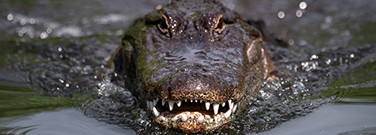Ancient Crocodiles May Have Walked Upright
By Gina Wynn
Researchers have recently uncovered evidence suggesting that some crocodile ancestors were even more fearsome than their swamp-dwelling, predatory descendants. Analysis of 110-million-year-old fossil footprints found in a South Korean rock formation shows that ancient crocodiles may have walked on their two hind legs, carrying their shorter front limbs T. rex style.
The study, published in Scientific Reports, wasconducted by Kyung Soo Kim of Chinju National University of Education in Kyungnam, South Korea; Martin G. Lockley of the University of Colorado, Denver; Jong Deock Lim of the National Research Institute of Cultural Heritage in Daejon, South Korea, and others.
Translating the Tracks
The fossil tracks were the first evidence of bipedalism in ancient crocodiles, also known as crocodylomorphs. From the size and spacing of the tracks, scientists believe they were similar in size to modern crocodiles — two to three meters long.
The well-preserved footprints were found in the Jinju Formation, where fossils of dinosaurs and other animals were also discovered. They were easily attributed to the genus Batrachopus, which are fossil tracks made by the crocodylomorph.
“Short of finding the animal dead in its tracks, there’s always a little bit of uncertainty,” according to Lockley, as reported in Carolyn Gramling’s Science News article “Fossil footprints show some crocodile ancestors walked on two legs.”
But the lack of hand prints in the tracks present strong evidence that the crocodylomorph walked on only its back legs. “We have dozens of these things, and not one sign of a front footprint, so we’re pretty convinced,” said Lockley.
Raging Relative
These aren’t the first findings that point to two-legged crocodile ancestors, however. Researchers speculate that a crocodylomorph (Carnufex carolinensi) that terrorized North America around 236 million years ago may have also been bipedal.
Its remains were discovered in the Pekin Formation in North Carolina. North Carolina State University and North Carolina Museum of Natural Sciences paleontologists published the 2015 study in Scientific Reports.
Fondly referred to as the “Carolina Butcher,” it is thought to have been a fierce predator during the Triassic period when creatures had to fight for supremacy before dinosaurs inhabited what is now the southern region of the United States.
But unlike the Jinju Formation crocodylomorph study that analyzed footprints, researchers reconstructed skeletal fossils to determine that the reptile may have walked on two legs.
Research Revisited
Kim, Lockley, Lim and team now also believe that fossil tracks they discovered in 2012 at the Haman Formation in South Korea were also made from bipedal crocodylomorphs. They originally believed them to be made by pterosaurs, a flying reptile that lived during the time of dinosaurs.
Because the tracks at the Jinju Formation presented such a detailed picture of the animal’s feet, it eliminated any doubt the group had about their findings at both sites. According to Kim, when Lockley identified the tracks as Batrachopus, Kim was skeptical, as reported by Tim Vernimmen for the National Geographic article “Mysterious crocodile relative may have walked on two legs.”
“I didn't believe it at that time, because I couldn't imagine a bipedal crocodile,” said Kim. “But later, I was convinced by the blunt toes, the toe pads, and the details of the skin.”
But it may take a while to convince others. The team hopes paleontologists will eventually find a fossil skeleton that matches with similar types of footprints. Then, according to Lockley, we would have an unmistakable link between a trace and a body fossil.
Discussion Questions
- Why might it be helpful for an animal to walk on two long legs rather than four short legs?
- What other animals of today look different from their ancient ancestors?
Vocabulary
- ancestors
- descendants
- bipedalism
- paleontologist
- pterosaur
- trace fossil


